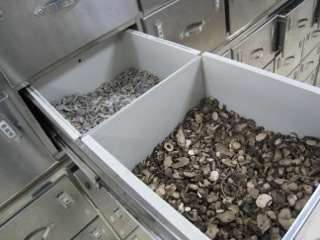By Anna Russo
I was staring into a cup that looked as if it had been filled directly from the murky waters of the Yellow River. Tiny grey grains floated in the yellow steaming liquid as a sickly sweet smell wafted up to my nose. “He ba!” my host mother commanded in her clear Xi’an accent. Her expectant gaze suggested that I had no choice but to follow her instructions and drink up, so I sipped the liquid between coughing fits and sneezes. My Chinese vocabulary did not contain the words to ask anyone about the contents of the strangely sweet concoction I had just consumed, so I merely smiled and pocketed the empty brown package, keeping it as a memento of yet another Chinese mystery I hoped to someday solve.
To a Westerner, the more effective alternative would have been rushing to the nearest hospital for a chest scan. But my cough disappeared, the harmonious recipe of herbs in my tea being no less researched than the biotechnology that makes up a chest scan. The systematic documentation and formation of Traditional Chinese Medicine (TCM) began over two thousand years ago. In volumes such as Huangdi Neijing, published as early as 400 BCE, Chinese scholars stressed the need for balance, among the body’s major organs (the lungs, kidney, liver, heart, and spleen), between the opposing forces of yin and yang and in the distribution of the life force, qi. Any sort of imbalance—too much or too little qi in any one organ, an excess of any single emotion, or an abundance of yang energy—would lead to sickness. This complex philosophy provides a simple explanation for a tradition of successful natural treatments, based on thousands of years of observation.

This centuries-long tradition did not vanish when China “opened up” to the Western world more than three decades ago. Instead, TCM has evolved from rural family medicine to a results-based system of diagnoses and treatments standardized in modern hospitals. Today, Traditional Chinese doctors face equally rigorous standards of certification as Western doctors. According to Sun Jianqun, a middle class resident of Southeastern Fujian province, the careers of Traditional and Western doctors are equally popular among China’s young professionals. Although the systems of medicine are markedly different, Chinese hospitals contain a surprising amount of fluidity and every Western educated doctor has taken courses in TCM.
Any patient seeking Western treatment has the option to walk down a hallway and enter the Traditional Wing, ubiquitous in every Western hospital in China. Particularly in China’s most prosperous cities, wealthy Chinese turn primarily to Traditional doctors to treat minor stress-related ailments, like high blood pressure and hyperglycemia, while relying on Western medicine when the diagnosis becomes serious. As Sun Jianqun describes the relationship, “In China, we trust Chinese medicine, and also we don’t reject Western medicine. It just depends on the situation.” Western and Traditional treatments build off of one another to form a fusion unique to 21st century China.
In addition to its historic role in the Chinese healthcare system, TCM may prove to hold a cutting edge place in global pharmaceutical research. Consider the traditional Chinese concoction of four herbs, called Huang Qin Tang, which has been used to treat gastrointestinal discomfort since 220AD. In 2003, Dr. Yung-Chi Cheng, the Henry Bronson Professor of Pharmacology at the Yale School of Medicine, used the ancient cure to create a remedy that enhances the cancer-fighting effects of chemotherapy and alleviates its side effects. Having already passed FDA Stage 1 trials, the herbal combination may become the first TCM treatment to receive FDA approval.

Cheng is not alone in envisioning “Western and Chinese medicines as cornerstones, together with other [traditional remedies,] for the development of future medicines.” He founded the Consortium on the Globalization of Chinese Medicine, which today comprises more than 100 institutions. Nearly half of its members are located in the US and Europe, and include Columbia University, McLean Hospital of Harvard Medical School, and Shanghai based Johnson & Johnson China.
Among the Consortium members is Dr. Yibing Feng at University of Hong Kong School of Chinese Medicine, who is investigating TCM’s role in treating liver disease. Many others have followed suit. Outside the Consortium, companies such as Chi-Med, a China based pharmaceutical, have achieved clinical success, with Chi-Med using a traditional herb to treat Inflammatory Bowel Disease.
“If it’s still in use after a thousand years there must be something right,” Cheng said, in a Wall Street Journal article on his research. He described Chinese medicine as a constantly “evolving” force, pulling from its ancient roots to integrate seamlessly and powerfully into today’s search for new cures and treatments. By combining TCM’s holistic and results-focused approach with Western medicine’s target-based methodology, Dr. Cheng and others hope to address the challenges that each system faces. Their hope, and prediction, is TCM’s full integration in hospitals and drugs around the world. Perhaps in a future flu season, the herbs contained in my cup of steaming yellow tea could be prescribed in hospitals across the U.S.
Anna Russo ’17 is in Berkeley College. She can be reached at anna.russo@yale.edu.
